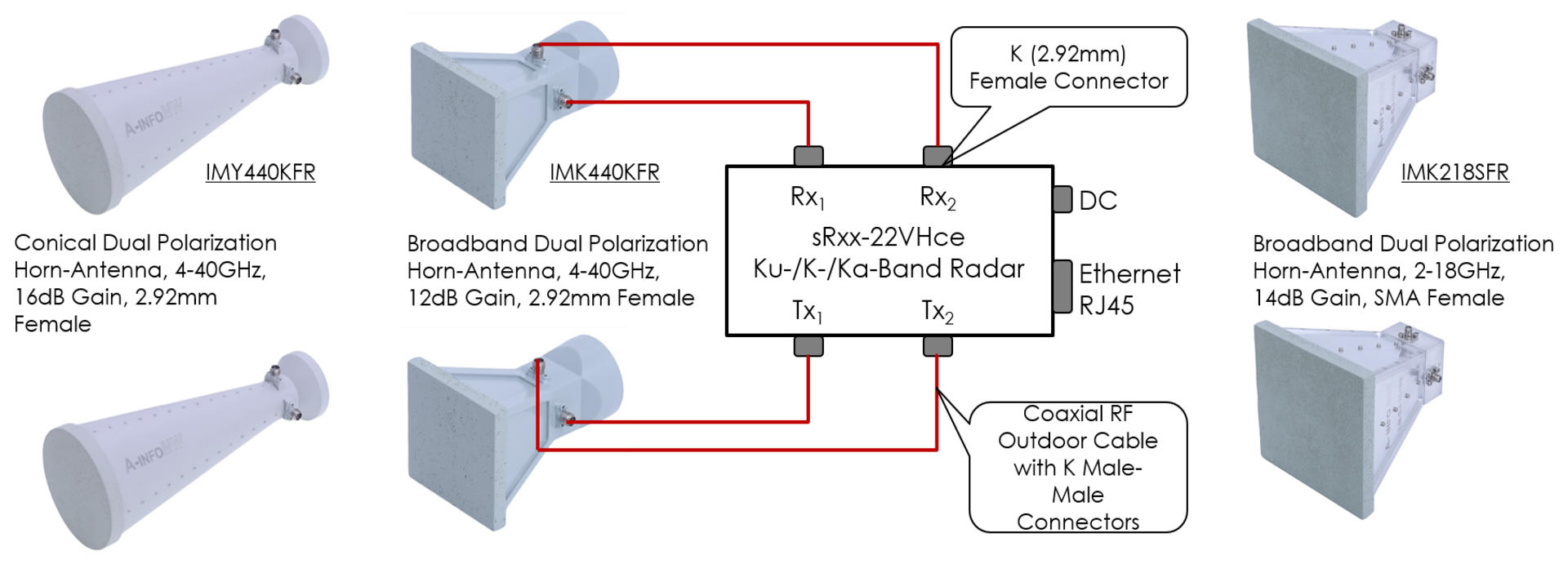IMST offers development services for dual polarization radars, which are based on the established technologies in the Ku-, K- and Ka-Band (13 & 17 GHz, 24.125 GHz, 35 GHz). By extending these existing designs with an additional transmission channel, the radars can be operated with dual-linear polarizations in transmitting and receiving. This enables signal-processing with full combination of vertical and horizontal polarization (HH, HV, VH, VV). This data can be used to characterize specific properties of the illuminated targets and areas, such as those used in earth observation from aircrafts or satellites. Two types of radar sensors can be offered:
- Sensors with integrated patch antennas
- Sensors with coaxial connectors for external (horn-) antennas
The typical frequency bandwidth of patch antennas is about 2 GHz while using horn antennas will allow frequencies bandwidths of 4 GHz or even higher. Higher bandwidth results in higher range resolution.
Option 1: Radar with Patch Antennas

Computer-generated Illustration of Dual Polarization Radar @ Ku-Band (13.5 & 17 GHz), K-Band (24 GHz) and Ka-Band (35 GHz)
The images above show the illustrated RF Frontends of the radars in their respective frequency bands, which are designed by IMST. With higher operating frequency, the patch antenna structures get smaller, creating the possibility of a smaller RF Frontend board. A minimum bandwidth of 2 GHz can be achieved with patch antennas. Higher bandwidths are also possible, depending on the frequency band. If higher bandwidths are desired, IMST is presenting a second option, using horn antennas as shown below.
Option 2: Radar with External (Horn-) Antennas

IMST's Radar Board extended with external Horn Antennas for Dual Polarization Radar
The second graphic shows IMST's radar sensors with coaxial connectors for external antennas. Horn antennas can be used in this option, taking advantage of higher frequency bandwidth. The two antennas on the left side of the graphic are able to cover all three Bands (13.5 & 17 GHz, 25.125 GHz, 35 GHz), while the antenna on the right side is for Ku-band only. Such radar systems are capable of achieving a bandwidth of more than 4 GHz. If dual polarization horn antennas are choosen as shown above, only two antennas are needed (one for Tx and one for Rx), which is another advantage of this option. IMST is providing the radar sensors with coaxial (K- or SMA-) connectors. Horn antennas from A-Info are recommended and need to be purchased externally.
Naming of Radar Sensors
Ku-/K-/Ka-Band Radar with internal Patch-Antennas or Coaxial Connectors for external (Horn-) Antennas
Device designation of modules with internal Patch Antennas: sRxx-22VHe
Device designation of modules with Coaxial Connectors: sRxx-22VHce
sRxx-22VHe / sRxx-22VHce
sR = sentire Radar
xx = Center Frequency
- Ku-Band: 13.5 GHz or 17.5 GHz
- K-Band: 24.125 GHz
- Ka-Band: 35 GHz
22 = 2 Transmit and 2 Receive Channels
VH = Vertical and Horizontal Polarization
c = Coaxial Connectors
e = Ethernet Interface
Are you interested in our development services?
Our team is looking forward to hearing from you.
Mehr erfahren